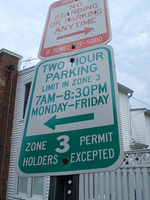Without balance, parking bills will hurt business
Parking on one side of every residential street in DC’s Wards 1 and 6 could be reserved for residents only, at all times of the day, under a pair of bills introduced by Jim Graham and Tommy Wells, the Councilmembers for those two wards. Tomorrow, the Council will hold a hearing on both bills, the Residential Parking Protection Pilot Act of 2009 and the Ward 6 Residential Parking Protection Pilot Act of 2009. In addition, one or both bills would provide visitor parking passes to residents, expand RPP sticker eligibility, and adjust RPP fees.
The first covers Adams Morgan, Mount Pleasant, Columbia Heights and U Street, while the second would encompass Capitol Hill, Southwest Waterfront, Near Southeast, and Mount Vernon Triangle. Both would reserve one side of every block with Residential Permit Parking (RPP) for residents of the individual wards. Households would each get one visitor pass to hand to daytime domestic workers or out-of-town visitors, entitling that visitor to park in a residential space. The Ward 1 bill also specifies that every household in the ward can receive a sticker for their car. Currently, residents of some apartment buildings facing commercial streets, or people who live on non-RPP zoned streets, are not eligible for the stickers, and thus receive no RPP privileges at all.
Is it right to reserve one side of every block for residents only? Many residents feel that curbside spaces outside the commercial areas are “theirs,” and residents ought to receive priority for the limited parking spaces available. Especially near popular nighttime destinations, visitors from other wards or outside DC park on residential blocks for free, and outside of RPP hours, often for a long period of time. I used to live right near Lauriol Plaza, in an area without off-street garages and where almost all parking spaces are residential. At night or on weekends, I’d need to circle for 15-30 minutes to find a parking space. On the other hand, preventing those visitors from parking in certain spaces without making it easier for them to find other spaces will also harm the businesses they patronize.
Reserving space for residents, like widening freeways, may only alleviate pressure in the very short term. Many people don’t own cars, and others pay relatively high rates to park in off-street garages. Making it easier for residents to park will only encourage more people to own cars or save cost of off-street garaging. The new cars vying for the same spaces will make on-street parking once again difficult. Therefore, this bill may only shift the equilibrium state to one with more resident cars. Moreover, by increasing eligibility for RPP stickers and adding visitor passes, even more cars can now occupy those spaces indefinitely, increasing demand.
Moreover, residents aren’t the only people who need to find spaces to park. Employees of local businesses do, and so do the patrons. The Mount Pleasant daytime parking pass program is the right solution for employees. Instead of keeping blocks unzoned for RPP, which invites abuse, or forcing employees to move their cars every two hours, which is illegal, the program lets employees buy a parking pass for a daily rate similar to one day’s bus fare. And, of course, many employees do reach their jobs by public transit.
That leaves shoppers, diners, and other patrons of the local businesses. Ideally, in dense areas like Ward 1, most patrons arrive by transit, but some do have to drive, whether because they live in car-dependent areas, can’t walk long distances, or many other reasons. If we simply make it harder for those people to reach our neighborhood commercial areas, they won’t.
New parking garages cost far too much money and further promote automobile dependence and traffic. DC first tried out reserving one side of each street as part of the performance parking pilots in Columbia Heights and Capitol Hill. There, we prohibited shoppers from using certain spaces, but also added meters to many spaces closer to the businesses and set the rates at market prices. The meters encouraged turnover. Patrons found it harder to park on residential streets, but easier to find metered spaces, and could confidently park near a restaurant for a tiny fraction of the price they spent on dinner.
Residents have been extremely happy with those pilots, particularly the part reserving one side of every street. Unfortunately, DDOT hasn’t seriously worked to prove the value of complete performance parking, overpricing some areas and limiting hours, and just not getting the meters installed. No wonder Councilmembers who initially supported the program are now picking it apart.
Nevertheless, a unified strategy is better than a piecemeal one. The performance parking pilots helped out residents and shoppers. Replicating one without the other could cause great harm. Residential parking scarcity is a problem for many residents. However, this bill isn’t the best solution, and doesn’t solve the entire problem. A few years ago, a Parking Task Force set up by Mayor Anthony Williams looked at the issues of parking, and formulated some more thorough recommendations. In the next installment, we’ll look at some of those and how the Council could improve these bills to actually help residents and businesses alike.

